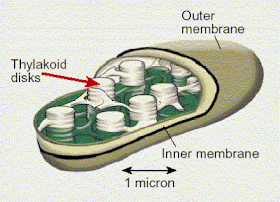An archaic ancestor
(a prokaryotic Cyanobean symbiont)
(a prokaryotic Cyanobean symbiont)
resides in our cell,
a case of organisms within organisms,
providing mutual benefit,
the recipe
for long-term evolutionary success.
Chloroplasts are organelles found in plant cells and other eukaryotic organisms that conduct photosynthesis and other chemical reactions. Chloroplasts capture the sun's light energy, store it in the energy storage molecules ATP and NADPH and use it in the process called photosynthesis to make organic molecules from carbon dioxide and free oxygen from water.
All chloroplasts contain the green pigment chlorophyll a, but not all chloroplasts are green because accessory pigments may be present that can change or override the green colour. The word chloroplast (χλωροπλάστης) is derived from the Greek words chloros (χλωρός), which means green, and plastis (πλάστης), which means "the one who forms". Chloroplasts are members of a class of organelles known as plastids.
Origin:They are considered to have originated from cyanobacteria through endosymbiosis. This was first suggested by Mereschkowsky in 1905 after an observation by Schimper in 1883 that chloroplasts closely resemble cyanobacteria. All chloroplasts are thought to derive directly or indirectly from a single endosymbiotic event (in the Archaeplastida), except for Paulinella chromatophora,
which has recently acquired a photosynthetic cyanobacterial
endosymbiont which is not closely related to chloroplasts of other
eukaryotes. In that they derive from an endosymbiotic event, chloroplasts are similar to mitochondria, but chloroplasts are found only in plants and protista.
The chloroplast is surrounded by a double-layered composite membrane
with an intermembrane space; further, it has reticulations, or many
infoldings, filling the inner spaces. The chloroplast has its own DNA , which codes for redox proteins involved in electron transport in photosynthesis; this is termed the plastome.













No comments:
Post a Comment